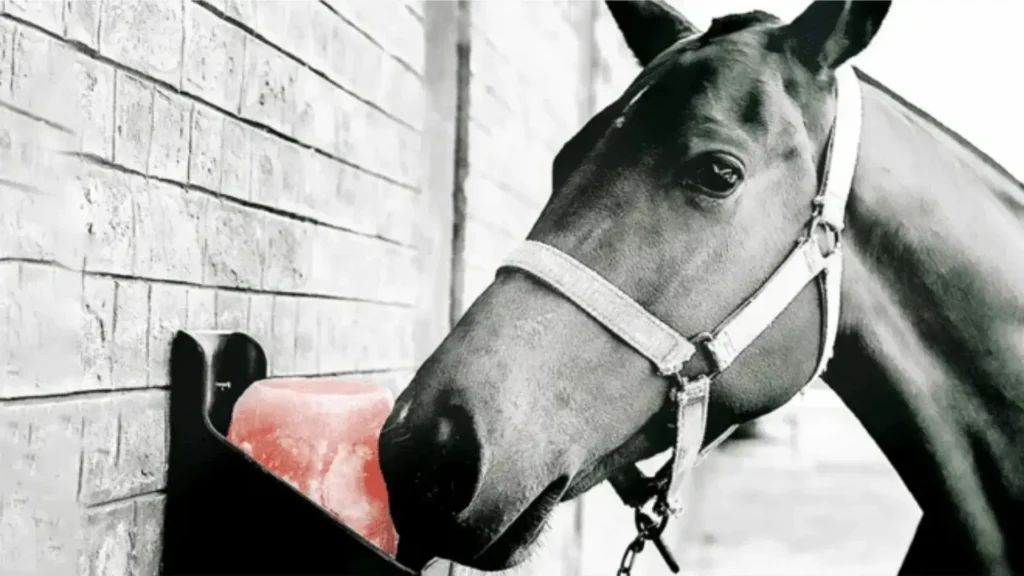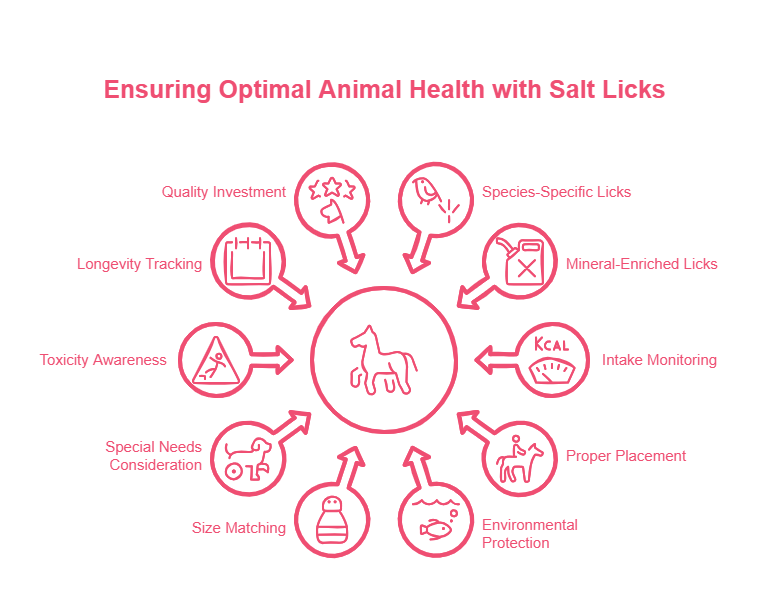
Salt licks are one of the simplest yet most powerful supplements you can give to animals. Whether it’s horses, cattle, sheep, goats, or even wild deer, salt licks provide essential minerals that keep animals healthy, strong, and productive. However, while they may seem straightforward, many caretakers unknowingly make mistakes when feeding animals salt licks. These mistakes can lead to poor mineral intake, health problems, or even dangerous toxicity.
In this blog, we’ll explore the most common mistakes when feeding animals salt licks, how to avoid them, and the best practices to ensure your animals get the nutrition they truly need.
Table of Contents
Why Salt Licks Are Important for Animals

Before diving into the mistakes, it’s important to understand why salt licks matter so much.
- Sodium & Chloride Balance – Animals need sodium and chloride for nerve function, digestion, and hydration.
- Mineral Support – Depending on the type, salt licks may provide calcium, magnesium, phosphorus, zinc, selenium, iron, and copper.
- Performance & Growth – Horses need salt to replace what they lose through sweat; cattle and goats need it for growth and reproduction; deer require minerals for antler growth.
- Prevention of Deficiencies – Without salt licks, animals can develop weakness, reduced milk production, poor appetite, and reproductive issues.
Salt licks are not just “extras” they’re a vital part of animal health.
Explore: Benefits Of Animal Salt Lick
10 Common Mistakes When Feeding Animals Salt Licks
Let’s break down the most common mistakes owners make and how you can avoid them.
1. Assuming One Salt Lick Fits All
Not all salt licks are made the same. Horses, cattle, sheep, and goats all have different mineral needs.
- Mistake: Giving a general salt block to every animal.
- Solution: Choose species-specific salt licks (e.g., copper-free for sheep, high-mineral licks for deer).
2. Ignoring Mineral Content
Some caretakers think “salt is salt.” But plain white salt lacks trace minerals that animals desperately need.
- Mistake: Providing only plain salt with no added minerals.
- Solution: Use mineral-enriched salt licks like Himalayan animal salt licks or specially formulated livestock mineral blocks.
Relying solely on salt blocks for trace minerals can result in up to 20% lower conception rates, calves that are 28 pounds lighter at weaning, and a 30% higher chance of issues like foot rot, making it worth considering more effective supplementation options for your herd’s health. [1]
Read: Mineral Composition of Himalayan Pink Salt and Its 84 Natural Elements
3. Overfeeding or Underfeeding Salt Licks
Just like humans, animals can suffer from too much or too little salt.
- Mistake: Leaving excessive amounts or restricting access too much.
- Solution: Monitor intake regularly. Consult feeding guidelines or ask a vet to determine the right balance.
When offering salt freely, cattle typically take in about 1.5 to 3 pounds per month in loose form, but they only consume around half that amount from blocks, which can lead to sneaky mineral deficiencies if you’re not careful. [2]
4. Placing Salt Licks in the Wrong Location
Placement matters more than you think.
- Mistake: Putting licks too close to water troughs (dissolves faster) or in hard-to-reach areas.
- Solution: Place them in shaded, dry, and easily accessible spots where animals naturally gather.
5. Ignoring Environmental Impact
Humidity, rain, and sun exposure affect salt licks.
- Mistake: Leaving blocks outdoors without cover.
- Solution: Use holders or shelters to keep them dry and long-lasting.
Studies show that 16 different mammal species use artificial salt licks just as effectively as natural ones, but in groups like cows, lower-ranking animals might lick them up to twice as variably due to competition, so providing enough for everyone helps ensure fair access. [3]
6. Using the Wrong Size of Salt Lick
The size of the salt lick matters depending on herd size and animal type.
- Mistake: Small licks for large herds (they finish too fast).
- Solution: Match block size with animal numbers and replace when needed.
7. Forgetting About Special Needs
Different stages of animal life require different nutrition.
- Mistake: Feeding the same lick to pregnant or lactating animals.
- Solution: Choose licks designed for breeding or lactating animals to support milk and reproduction.
8. Ignoring Toxicity Risks
Sheep are especially sensitive to copper.
- Mistake: Using cattle or horse licks for sheep.
- Solution: Always check labels and choose salt licks designed for your animal species.
Did You Know?
For cattle, horses, and swine, consuming salt at around 2.2 grams per kilogram of body weight can be fatally toxic, while dogs might show serious signs starting at 2–3 grams per kilogram with over 50% mortality rates even after treatment. [4]
9. Not Monitoring Longevity
Caretakers often don’t track how long salt licks last.
- Mistake: Allowing them to run out, leading to gaps in nutrition.
- Solution: Keep a replacement schedule and monitor consumption regularly.
10. Believing All Salt Licks Are Equal
From Himalayan salt licks to flavored or mineral-enhanced blocks, not all are created equal.
- Mistake: Buying the cheapest block available.
- Solution: Invest in natural and high-quality options like Sobaan Salts’ Himalayan Animal Salt Licks, which provide pure, balanced minerals.
Did You Know?
Supplements with more than 5% salt can cut dry matter intake by up to 15% in animals like beef heifers, while also boosting their water requirements by 50–75% sometimes adding up to 5 extra gallons per pound of salt so always keep fresh water plentiful and nearby. [5]
Common Mistakes vs. Best Practices in Salt Lick Feeding
Common Mistake | Best Practice |
One salt lick for all animals | Choose species-specific salt licks |
Only plain salt provided | Use mineral-enriched licks (Himalayan, trace mineral blocks) |
Overfeeding or underfeeding | Monitor intake and consult feeding guidelines |
Wrong placement (wet or far areas) | Place in shaded, dry, and accessible areas |
Ignoring environment (rain, humidity) | Use holders/shelters to protect licks |
Using wrong block size | Match block size to herd size |
Same lick for all life stages | Provide special licks for breeding/lactating animals |
Feeding sheep high-copper licks | Use sheep-specific salt blocks without copper |
Not monitoring duration/consumption | Replace licks on schedule |
Choosing cheapest low-quality block | Opt for natural, mineral-rich salt licks |
Best Practices for Feeding Animals Salt Licks
Now that we’ve looked at the mistakes, let’s focus on what to do instead:
- Always match salt lick type to species and age.
- Keep licks in sheltered, accessible spots.
- Rotate between plain and mineral licks to prevent imbalances.
- Monitor herd behavior – if some animals dominate the block, consider placing multiple.
- Choose natural, high-quality salt licks (like Sobaan Salts’ Himalayan Salt Licks).
Read: Are Salt Lamps Bad for Cats? A Must-Read Guide for Pet Owners
Final Thoughts
Salt licks may look simple, but using them incorrectly can harm your animals more than help. By avoiding the common mistakes when feeding animals salt licks such as wrong placement, ignoring species needs, or overfeeding you can ensure your livestock and wildlife get the exact minerals they need.
When in doubt, consult a vet or livestock nutritionist to design the perfect mineral plan. With the right approach, your animals will thrive with better growth, reproduction, milk production, and overall health.
At Sobaan Salts, we believe in providing animals with the purest, most natural Himalayan Animal Salt Licks to support long-term wellbeing.
Mineral deficiencies are extremely common on pastures across the U.S., with 60% or more of cattle potentially suffering from copper deficiencies and 10% to 70% affected by selenium deficiencies depending on location. Analysis of 1,113 forage samples from Oklahoma and Texas revealed only 14.6% provided adequate zinc and 39.4% adequate copper, highlighting the need for targeted supplementation like mineral-enriched salt licks to prevent health and productivity issues. Source: Beef Magazine – The Mineral Supplementation Predicament on Pasture.
References:
Share This Post
Article By

